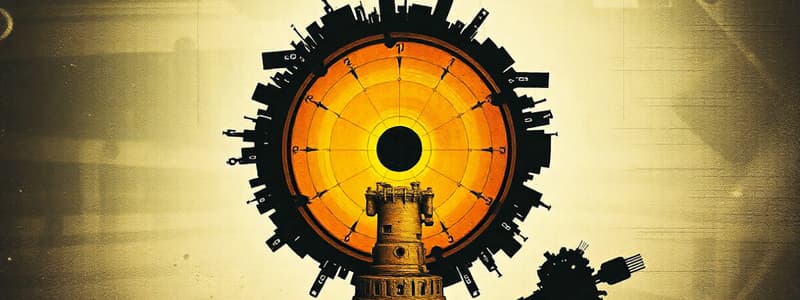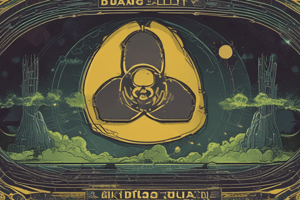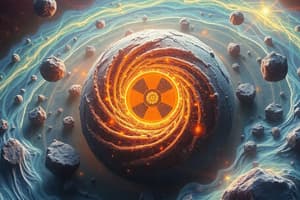Podcast
Questions and Answers
Which of the following options describes the process of alpha decay?
Which of the following options describes the process of alpha decay?
- An unstable nucleus emits an alpha particle, reducing its atomic number. (correct)
- Two light nuclei combine to form a heavier nucleus, releasing energy.
- A heavy nucleus splits into smaller nuclei, releasing energy and neutrons.
- A nucleus absorbs a neutron and becomes unstable.
What key characteristic distinguishes nuclear fission from other nuclear processes?
What key characteristic distinguishes nuclear fission from other nuclear processes?
- It combines light nuclei.
- It splits a heavy nucleus into lighter ones. (correct)
- It only occurs in stars.
- It involves the emission of alpha particles.
What conditions are essential for initiating and sustaining nuclear fusion?
What conditions are essential for initiating and sustaining nuclear fusion?
- Extremely high temperature and pressure. (correct)
- High temperature and low pressure.
- Moderate temperature and pressure with a catalyst.
- Low temperature and high pressure.
Why is the management of spent fuel rods a critical safety concern in nuclear power plants?
Why is the management of spent fuel rods a critical safety concern in nuclear power plants?
What distinguishes gamma radiation from alpha and beta radiation?
What distinguishes gamma radiation from alpha and beta radiation?
What role do gluons play in the strong nuclear force?
What role do gluons play in the strong nuclear force?
How does radiation exposure affect human tissue, and in what unit is it measured?
How does radiation exposure affect human tissue, and in what unit is it measured?
What property of alpha particles makes them relatively safe outside the body but dangerous if ingested?
What property of alpha particles makes them relatively safe outside the body but dangerous if ingested?
What is the primary function of a containment structure in a nuclear facility?
What is the primary function of a containment structure in a nuclear facility?
Why is Uranium-235 significant in the context of nuclear reactors and weapons?
Why is Uranium-235 significant in the context of nuclear reactors and weapons?
What effect does beta decay have on the composition of an atomic nucleus?
What effect does beta decay have on the composition of an atomic nucleus?
In nuclear equations, what principle must always be conserved?
In nuclear equations, what principle must always be conserved?
What defines the half-life of a radioactive isotope?
What defines the half-life of a radioactive isotope?
How does a short half-life affect the danger posed by a radioactive source?
How does a short half-life affect the danger posed by a radioactive source?
What is the difference between irradiation and contamination?
What is the difference between irradiation and contamination?
Why are beta and gamma sources more dangerous outside the body compared to alpha sources?
Why are beta and gamma sources more dangerous outside the body compared to alpha sources?
How are gamma sources typically used in medical tracers?
How are gamma sources typically used in medical tracers?
What is the purpose of using radiation in radiotherapy for treating cancer?
What is the purpose of using radiation in radiotherapy for treating cancer?
What is a key consideration when determining whether to use radiation for medical purposes?
What is a key consideration when determining whether to use radiation for medical purposes?
In the context of nuclear fission, what is meant by a 'chain reaction'?
In the context of nuclear fission, what is meant by a 'chain reaction'?
Flashcards
What is alpha decay?
What is alpha decay?
Radioactive decay where an unstable nucleus emits an alpha particle, resulting in a new element with reduced atomic number.
What is nuclear fission?
What is nuclear fission?
A process where a heavy nucleus splits into lighter nuclei, releasing energy and neutrons.
What is nuclear fusion?
What is nuclear fusion?
A process where light nuclei combine to form a heavier nucleus, releasing tremendous energy.
What is nuclear radiation?
What is nuclear radiation?
Signup and view all the flashcards
What is strong nuclear force?
What is strong nuclear force?
Signup and view all the flashcards
What are alpha particles?
What are alpha particles?
Signup and view all the flashcards
What are beta particles?
What are beta particles?
Signup and view all the flashcards
What are gamma rays?
What are gamma rays?
Signup and view all the flashcards
What is ionizing radiation?
What is ionizing radiation?
Signup and view all the flashcards
What is Uranium-235?
What is Uranium-235?
Signup and view all the flashcards
What is Plutonium-239?
What is Plutonium-239?
Signup and view all the flashcards
What is the atomic number?
What is the atomic number?
Signup and view all the flashcards
What is the mass number?
What is the mass number?
Signup and view all the flashcards
What are isotopes?
What are isotopes?
Signup and view all the flashcards
What is half-life?
What is half-life?
Signup and view all the flashcards
What is background radiation?
What is background radiation?
Signup and view all the flashcards
What is irradiation?
What is irradiation?
Signup and view all the flashcards
What is contamination?
What is contamination?
Signup and view all the flashcards
What is nuclear fission?
What is nuclear fission?
Signup and view all the flashcards
What is nuclear fusion?
What is nuclear fusion?
Signup and view all the flashcards
Study Notes
Alpha Decay
- Radioactive decay where unstable nucleus emits an alpha particle
- Alpha particle consists of two protons and two neutrons
- Results in a new element with a reduced atomic number
- Alpha particles are positively charged
- Can be stopped by paper or skin
- Decreases the mass number of the original atom by four and atomic number by two
- Uranium-238 and Radium-226 are common alpha-emitting isotopes
- Typically occurs in heavy elements seeking stability by reducing mass and atomic number
Nuclear Fission
- The process where a heavy atomic nucleus splits into two or more lighter nuclei
- Releases significant energy and neutrons, which can induce additional reactions
- Uranium-235 and plutonium-239 are common fissile materials
- Fission reactions are used in nuclear reactors for energy production
- If uncontrolled, the process can lead to a chain reaction
- Chain reaction can cause nuclear explosions
- Handling fissionable materials requires safety measures to prevent nuclear accidents
Nuclear Fusion
- The process where two light atomic nuclei combine to form a heavier nucleus
- Releases tremendous energy
- Powers stars like the Sun
- Has potential for sustainable energy on Earth
- Requires extremely high temperature and pressure to overcome electrostatic repulsion
- Deuterium and tritium are common isotopes used, often yielding helium and a neutron
- Fusion has abundant fuel supply, minimal long-lived radioactive waste (compared to fission)
- Research focuses on controlled fusion in reactors like tokamaks and inertial confinement
Nuclear Radiation
- Emission of energy and particles from unstable atomic nuclei
- Includes alpha particles, beta particles, and gamma rays
- Alpha particles: two protons and two neutrons, low penetration, stopped by paper
- Beta particles: high-energy electrons or positrons, more penetrating than alpha particles, stopped by plastic or glass
- Gamma rays: electromagnetic radiation with high energy and deep penetration, requires lead or concrete shielding
- Radiation exposure measured in sieverts (Sv), indicating biological effects on human tissue
Strong Nuclear Force
- One of the four fundamental forces
- Holds protons and neutrons together in atomic nuclei
- Overcomes electromagnetic repulsion between charged particles
- Operates at very short ranges, about 1 femtometer (10^-15 meters)
- Gluons mediate the force between quarks within protons and neutrons
- Strength increases at shorter distances
- Much stronger than electromagnetic and gravitational forces, acts at subatomic scales
Types of Radiation
- Energy emitted from unstable atomic nuclei
- Classified into alpha, beta, and gamma radiation
- Alpha radiation: helium nuclei, heavily charged, low penetration, stopped by paper/skin
- Beta radiation: high-energy electrons/positrons, more penetration than alpha, stopped by plastic
- Gamma radiation: high-energy electromagnetic, highly penetrating, requires lead/concrete
- Radiation can be natural (cosmic, terrestrial) or artificial (nuclear reactors, medical applications)
Alpha Particles
- Positively charged, consist of two protons and two neutrons
- Emitted during the decay of heavy atomic nuclei
- Low penetration power, stopped by paper or skin
- Carry a +2 charge
- Strongly ionizing, can cause significant damage to biological tissues
- Alpha decay occurs often in heavy elements
- Not typically dangerous unless ingested or inhaled
Beta Particles
- High-energy, high-speed electrons or positrons
- Emitted during radioactive decay
- Classified as beta-minus (electrons) or beta-plus (positrons)
- More penetrating than alpha particles, less than gamma rays
- Results in transformation of a neutron into a proton (or vice versa)
- Can have a negative or positive charge
Containment Structure
- Robust, engineered barrier
- Prevents release of radioactive materials during accidents or system failures
- Made of reinforced concrete and steel for strength and durability
- Designed to withstand earthquakes, floods, and explosions
- Often includes multiple layers like pressure vessels and domes
- Regular inspections and maintenance are crucial
Fuel Rods
- Cylindrical tubes containing nuclear fuel, typically enriched uranium or plutonium pellets
- Used in reactors to sustain nuclear fission reactions
- Arrangement in reactor core influences neutronic behavior and heat generation
- Made of zirconium alloys to withstand high temperatures and corrosion
- Spent fuel rods become highly radioactive
- Require secure storage and management for thousands of years
- Regular inspections and maintenance needed to ensure integrity and safety
Gamma Rays
- High-energy electromagnetic waves
- Emitted during radioactive decay
- Have the shortest wavelength and highest frequency
- Can penetrate most materials
- Require dense shielding like lead or thick concrete
- Used in cancer radiotherapy to target and destroy malignant cells
- Detected by Geiger counters and scintillation detectors
Ionizing Radiation
- Particles/electromagnetic waves with sufficient energy to detach electrons from atoms, creating ions
- Can damage biological tissues, leading to potential health risks
- Includes alpha particles, beta particles, gamma rays, and X-rays
- Exposure measured in sieverts or rems
- Shielding and monitoring devices used in areas with ionizing radiation sources
Plutonium-239
- Radioactive isotope with a half-life of 24,100 years
- Used as fuel in nuclear reactors and atomic bombs
- Produced from uranium-238 through neutron capture and subsequent beta decay
- Emits alpha particles, posing health risks if ingested or inhaled
- Critical for breeder reactors to enhance nuclear fuel sustainability
- Its critical mass 10 kg in a spherical shape
Uranium-235
- Fissile isotope of uranium that sustains nuclear chain reactions
- Crucial for reactors and nuclear weapons
- Occurs at about 0.72% in uranium, can be enriched for reactor use
- Fission releases energy and neutrons that enable further reactions
- Used as fuel in pressurized and boiling water reactors
- First used in the 'Little Boy' bomb dropped on Hiroshima
Studying That Suits You
Use AI to generate personalized quizzes and flashcards to suit your learning preferences.




